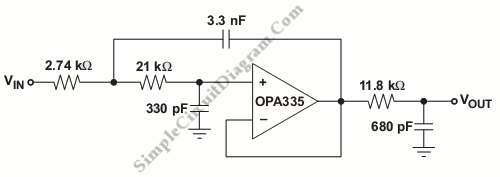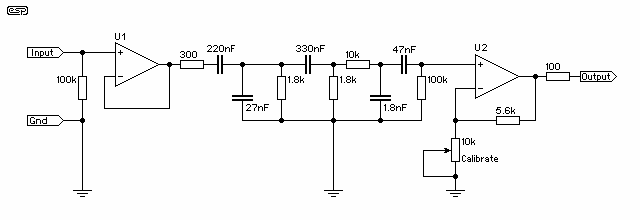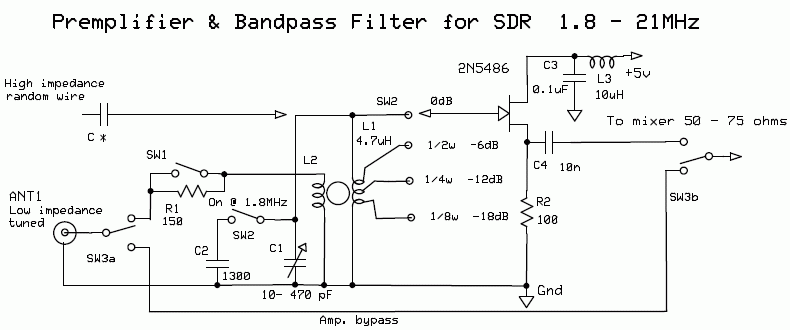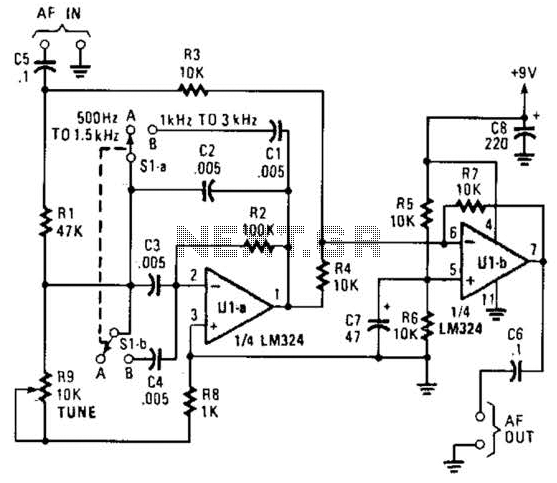
A 20-kHz Third-Order Low-Pass Filter

This is a third-order low pass filter with a corner frequency of 20 kHz, which is twice the auto-zero clock frequency.
The third-order low pass filter is designed to attenuate high-frequency signals while allowing low-frequency signals to pass through with minimal loss. The specified corner frequency of 20 kHz indicates the point at which the output signal power drops to half of the input signal power, corresponding to a -3 dB point in the frequency response.
The circuit typically consists of resistors and capacitors arranged in a specific configuration to achieve the desired filtering characteristics. In a third-order configuration, three reactive elements are utilized. This can be achieved through various configurations, such as using a combination of RC (resistor-capacitor) or RLC (resistor-inductor-capacitor) elements.
For a standard RC low pass filter, the components can be arranged in either a passive or active configuration. A passive third-order low pass filter can be constructed using three capacitors and two resistors, or alternatively, using two capacitors and one resistor in conjunction with an operational amplifier to create an active filter.
In terms of component values, the selection of resistors and capacitors will directly influence the corner frequency and the roll-off rate of the filter. The roll-off rate for a third-order filter is -60 dB/decade, meaning that for every tenfold increase in frequency beyond the corner frequency, the output signal will decrease by 60 dB.
The design also requires careful consideration of the load impedance and the source impedance to ensure optimal performance. Additionally, attention must be paid to the layout of the circuit to minimize parasitic capacitance and inductance, which can adversely affect the filter's performance.
In summary, the third-order low pass filter with a corner frequency of 20 kHz is a critical component in various electronic applications, providing effective signal conditioning by filtering out unwanted high-frequency noise while preserving the integrity of lower frequency signals.This is a third order low pass filter that has corner frequency of 20kHz. It is twice as high as the auto-zero clock frequency. Here is the circuit : The input.. 🔗 External reference
The third-order low pass filter is designed to attenuate high-frequency signals while allowing low-frequency signals to pass through with minimal loss. The specified corner frequency of 20 kHz indicates the point at which the output signal power drops to half of the input signal power, corresponding to a -3 dB point in the frequency response.
The circuit typically consists of resistors and capacitors arranged in a specific configuration to achieve the desired filtering characteristics. In a third-order configuration, three reactive elements are utilized. This can be achieved through various configurations, such as using a combination of RC (resistor-capacitor) or RLC (resistor-inductor-capacitor) elements.
For a standard RC low pass filter, the components can be arranged in either a passive or active configuration. A passive third-order low pass filter can be constructed using three capacitors and two resistors, or alternatively, using two capacitors and one resistor in conjunction with an operational amplifier to create an active filter.
In terms of component values, the selection of resistors and capacitors will directly influence the corner frequency and the roll-off rate of the filter. The roll-off rate for a third-order filter is -60 dB/decade, meaning that for every tenfold increase in frequency beyond the corner frequency, the output signal will decrease by 60 dB.
The design also requires careful consideration of the load impedance and the source impedance to ensure optimal performance. Additionally, attention must be paid to the layout of the circuit to minimize parasitic capacitance and inductance, which can adversely affect the filter's performance.
In summary, the third-order low pass filter with a corner frequency of 20 kHz is a critical component in various electronic applications, providing effective signal conditioning by filtering out unwanted high-frequency noise while preserving the integrity of lower frequency signals.This is a third order low pass filter that has corner frequency of 20kHz. It is twice as high as the auto-zero clock frequency. Here is the circuit : The input.. 🔗 External reference





